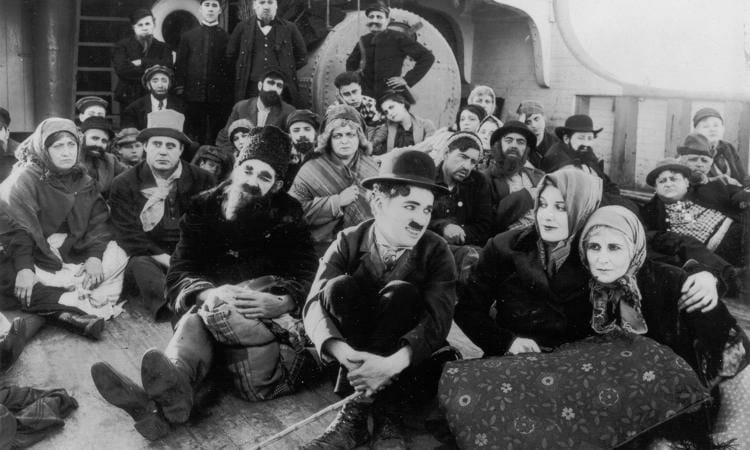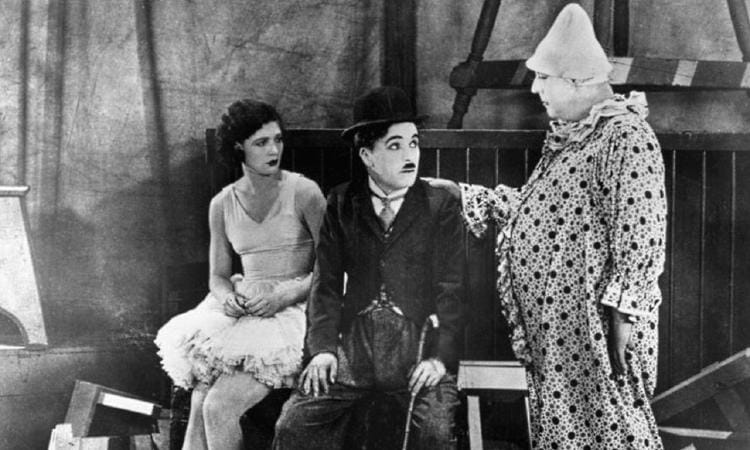By Monica Terada · January 30, 2014


I feel like Chaplin’s movies have gone underappreciated by my 1980’s/90’s generation of friends – are they mad? All that my friends seem to know about him is that he does this eccentric little walk. But behind the eccentric walk, and his clumsy actions, which are hilarious, lies a very meticulous and demanding storyteller. Before shooting a movie, Chaplin wrote and re-wrote; revised and “re-revised”. And while shooting, he directed and “re-directed,” and shot the same scene over and over again. He created his own studio so he would have the final say in all of his movies. As a result, movies of very intelligent wit were produced. Chaplin’s movies are never just a comedy of slapstick: they present an astute reflection of contemporary times, sometimes with much humor (Modern Times), and other times, with much more humor, followed by a poignant message (The Great Dictator). And in most of his movies, “The Little Tramp”, Chaplin’s most memorable character, is there to grace the screens.
Charlie Chaplin’s movies were universally recognized and acclaimed; most were made during the silent era of film, and included universal themes of war, love, and money. His movies were, first and foremost, hilarious, but they also touched a nerve in people, due to their astute observations.
This list is dedicated to those who have not yet fully experienced Chaplin’s brilliant humor, and whose nerves need a little touching. Here goes the Top 10 Best of one of the world’s best storytellers.

10. The Immigrant (1917)
Unsteady on his feet, as the ship rocks back and forth, The Little Tramp makes his way to America. The Immigrant is a very amusing short from 1917, and a strong example of Chaplin’s style. It includes much humor on the ship to America, and off the ship in America as well. Here we start to see many of his future movie characters take shape, such as, the big brute from The Gold Rush and the vulnerable “damsel in distress” from City Lights. In The Immigrant the Tramp plays cards, or, I should say, steals at cards, from a brute much like the one he tries to deceive in The Gold Rush as well. Also, the short includes one of Chaplin’s most consistent themes, which is, the relation of love and money. On his way to America he meets a humble, but beautiful, young lady. He gives her the money he had won from stealing at cards: an action he will continue to do in many of his subsequent films, because, love is above money.
The Immigrant reveals The Little Tramp’s mischievous, yet, altruistic nature. Chaplin’s humoristic style and persistent themes are all over this movie: it’s a great example of his work.

9. Sunnyside (1919)
Best introduction and ending in all of his shorts. Hilarious! Charlie plays a farm hand and handyman, except he neither gives a hand, nor is handy. By the time he gets out of bed, “the whole forenoon is gone.” And when he’s not sleeping – on the job – he’s causing trouble. He loses an entire herd of cows for crying out loud! Okay, okay, he does look very hard for them afterwards: behind a tree and somewhere within the bushy grass…no luck however. That is, until one of them leaps out of a window. And another one causes a commotion inside the church!
But Sunnyside includes more than cow-leaps: nymph-leaps and Charlie-leaps as well. And I love it when Charlie leaps! And skips and prances about like a “girl.” It’s adorable, and hilarious. He does it in many of his movies and in this one, he does it so well, in the end he goes home with a gal…the beautiful Village Belle (Edna Purviance).
Sunnyside makes the list especially for its girly skips: a Chaplin classic, which can be seen here at their best performance.

8. Limelight (1952)
“The meaning of anything is merely other words for the same thing. After all, a rose is a rose is a rose.”
Calvero (Chaplin) was once a great comedian and Thereza (Claire Bloom) a great ballerina; but Calvero’s jokes have become obsolete and Thereza can no longer dance, due to an impeding psychosis. Life has lost its meaning for both of them, until, they find each other, and life suddenly acquires “other words,” giving it a different view.
The movie is deep: very, very deep, and reveals a lot of Chaplin’s soul. The old comedian says to the young ballerina, “As a child I used to complain to my father about not having toys, and he would say, ‘This (pointing to his head) is the greatest toy ever created. Here lies the secret of all happiness.’”
The movie reflects Chaplin’s real life struggles to find happiness and attribute meaning to his life. After having reached the status of one of the world’s most popular entertainer, what is there left? “Well,” says Calvero, “at this stage of the game, life gets to be a habit.” But I feel this movie reveals Chaplin comes to terms with his life, because, “the fight for happiness is beautiful.”

7. The Circus (1928)
The Little Tramp finally discovers where he truly belongs: The Circus. He’s a complete riot and the star of the show, but he doesn’t know it. And of course, the one to explain it to him is the beautiful acrobat he falls in love with, Merna (Merna Kennedy), after sharing a slice of bread. The girl is famished, and although the Tramp is as well, he is too kindhearted not to share. The two become friends and Chaplin proceeds to fall in love and prance about in “girly” skips. The movie is arguably – and laughably – his funniest. I definitely laughed enough for it to be…

6. Monsieur Verdoux (1947)
A comedy of murder: Monsieur Verdoux (Charlie Chaplin) is a bluebeard! Although he will go out of his way not to step on a little caterpillar, he marries a series of wealthy women and murders them for their money.
The movie was not well received in the United States when it came out in 1947, probably because the hordes still wanted to see The Little Tramp. But I argue that although Monsieur Verdoux is a killer of loaded women, there’s still a hint of the Tramp inside him. His reasons for murder are as noble as can be, or so he thinks. He’s lost his lifelong career as a bank teller and needs to support his son and invalid wife, so murdering becomes his new career, and it’s just as noble as any other. Verdoux believes his reasons are plausible; all he really cares about in the world are his wife and child.
It’s Chaplin’s only murder comedy, and it’s replete with both…murders and comedy, that is. At his murder trial Monsieur Verdoux says, “I do not wish to lose my temper, because very shortly, I shall lose my head.”

5. The Kid (1921)
One of the things that really fascinates me about Chaplin is the fact that he not only wrote, directed, starred in, and produced his movies, he also composed the musical score. And what a score this movie has! Fits in perfectly with all the incredibly funny and incredibly touching scenes.
In the beginning of the movie the Tramp goes out for his morning promenade and stumbles across, not only piles of trash, but a little baby boy (Jackie Coogan) as well. After some failed attempts to get rid of the kid – including putting him in a baby carriage with another random kid – the Tramp decides to keep him.
The movie goes from an extremely funny beginning, with perfectly well-timed comedic scenes, performed by both Chaplin and the kid, to a truly touching ending. Both Chaplin and Coogan deliver endearing performances and what especially stands out in the movie, aside from the brilliant musical score, is Chaplin’s mastery of both comedy and drama. The movie ends with a spectacular dream sequence and a very last scene that is sure to bring tears to your eyes.

4. Modern Times (1936)
Modern Times is a great example of Chaplin’s genius in satirizing “contemporary” issues, in this case, the industrial revolution. The Little Tramp is an assembly worker who works so hard he continues to “assemble” things even after leaving work: his body has become so accustomed to the repetitive motions that they carry on repeating them.
One of the most magnificent inventions of the machine age is the “Bellows Feeding Machine.” Now workers won’t even have to stop for lunch! The machine feeds them while they are working, making workers even more cost efficient and almost completely transforming them into robots.
The movie analyzes the inhumanity of this machine age: workers have become expendable arms in a systematic assembly line. Speed is all that matters and if you are unable to fulfill the demands, another worker will be there to take your place. I admire Chaplin’s ability to bring humor to such a gloomy and dreary existence.

3. The Gold Rush (1925)
As the name suggests, the movie is about a rush for gold, and the setting is the freezing landscapes of Alaska. There are many unforgettable scenes in the movie: the Little Tramp sharing a cooked shoe for Thanksgiving dinner with Big Jim, the struggle to get out of the falling house (dangerously hanging from the edge of a cliff), and, of course, the most amazing dance in the history of cinema: the dinner roll dance! Chaplin’s famous little dance where he places two dinner rolls at the end of forks and performs with them. A magnificent performance that went on to be copied by Johnny Depp, in Benny and Joon, and Grandma Simpson, in the episode, Lady Bouvier’s Lover. The Gold Rush is one of Chaplin’s most famous movies, precisely because of all the memorable scenes.

2. The Great Dictator (1940)
“Tomania has the greatest army in the world,” proclaims Hynkel (Charlie Chaplin), dictator of the nation. But in order to continue that way, sacrifices must be made: belts must be tightened! But Heir Herring is way too overweight to tighten his belt and Heir Garbitsch (pronounced Garbage) thinks Hynkel needs to make more violent references to the Jews…things have been too quiet in the Ghettos.
The Great Dictator succeeds in making fun of possibly one of the most horrific historical figures of all times, Hitler. It is primarily a comedy, but ends on a very serious note, with Chaplin looking straight into the camera and delivering a touching speech of values and hope. Many feel like the ending does not work, due to its abrupt shift from comedy to reality, but I feel like it made the movie. Of course, Chaplin did not know at the time the horrific outcomes of Hitler’s dictatorship, but watching the movie now makes us appreciate the speech even more.

1. City Lights (1931)
City Lights is Chaplin’s masterpiece. It has a brilliant soundtrack, a beautiful Virginia Cherill as the blind, but lovely, flower girl, and an endearing storyline, filled with many laughs and impressive Chaplin foot action in a boxing ring.
The Little Tramp is known in all of his movies as a character of compassion, and although he is, well, a tramp, he always shares the little he has. City Lights is the movie that depicts this best, with an innocent premise of the Tramp wanting to help a blind girl restore her vision, and a perfect ending that restores not only her vision, but hope in humanity as well.